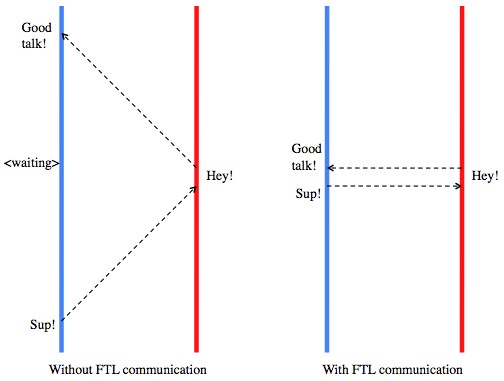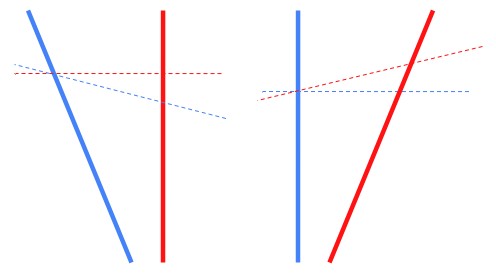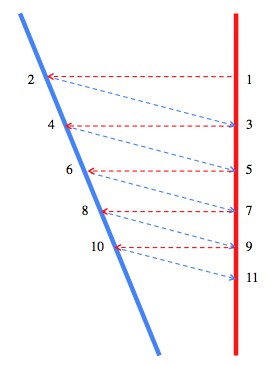Physicist: You may have heard that if a technique can be found that allows you to send a signal faster than light, then you can send a signal back in time. The very short answer for why is that relativity causes some problems when you try to define “instant”, and those problems can be used to send signals back in time.
The speed of light is crazy fast, but on large enough distances it’s agonizingly slow. Talking to people on the Moon involves a net 2 second delay, which is a little annoying. If you send a signal to a robot on Mars it’ll take between 8 and 40 minutes to get a response, depending on where Mars and Earth are in their orbits, which is crippling (this is a big part of why the rovers were made to be fairly independent). So why not just create some kind of sub-space, tachyon, ultrawave relay, thingy that allows you to send FTL (faster than light) or even instantaneous signals?

Any physically realizable communication always involves some delay (left), instantaneous communication doesn’t seem to cause any problems (right), but it totally does. In all of these pictures time moves from the bottom to the top.
Relativity does more than just place a cap on the speed that signals and objects can move. It also muddles this question in particular, by complicating what’s meant by “instantaneous”. One of the unfortunate results of relativity is what’s happening “now” depends on how fast (and in which direction) you’re moving. That is, if one person sees that two events are happening at the same time (“right now”), then someone traveling at a different speed will see the two events not happening at the same time.
In particular, if you send an instantaneous signal to somewhere else, then the sending and arriving both happen “now”, but to someone else (moving relative to you) one happens before the other.

Two objects, as well as a couple moments from each of their perspectives. (left) The red object is stationary. (right) The blue object is stationary. Notice that the “nows” of the two objects are skewed with respect to each other.
The details of why can be found here, but for now just keep in mind that when something passes by, the set of things that are happening “right now” for that thing happen later for you in the direction of motion. So, if something passes left to right in front of you, then its now will, for you, happen in a moment and to the right as well as a moment ago and to the left (whens and wheres get mixed up a bit in relativity). It takes a little pondering (done in the link above), but this result actually falls out of the whole “speed of light is the same to everyone” thing pretty quickly.
By the way, that shouldn’t make any intuitive sense, and should be difficult to keep track of, so don’t stress.
So, “instantaneous communication” isn’t as easy to define as one might think. But, if you accept the basic tenet of relativity, that everything no matter how it’s moving is on equal footing, then one person’s instantaneous signal is merely traveling very fast to someone else, or even slightly backward in time to another someone else. So, say you have two objects sending instantaneous (from each of their perspectives) messages back and forth. Because of how they’re moving, while the sender perceives the message being sent and received instantly, the recipient perceives the message arriving a little after or even a little before it was sent.

Since differently moving things have different notions of now, instantaneous signals can zig-zag backwards or forwards in time.
Getting a message after it was sent is no biggie. I mean; write yourself a letter if you want to see that in action. But getting a message before it was sent causes issues (see for example; practically every sci-fi franchise). What those issues are exactly depends on how time travel works (e.g., “Timecop” or “Back to the Future” rules?), and that’s wide open to debate.
There is a “cure” for faster-than-light communication causing causality violations. There isn’t really a problem with signals going back in time, if they only go back in time somewhere else. For example,imagine there was a magic post office in the year 1500 that sent letters from Rome (Rome) to Tenochtitlan (Mexico City) and one week back in time. Since it took 5 weeks to cross the Atlantic, there’s no risk of paradoxes and causality violations (“Dear Ahuitzotl, in a week Giovanni Borgia is going to be killed. Nothing you can do about it, just thought you’d like to know.”). The real problems crop up when you can send instantaneous messages in two or more reference frames. That allows you to bounce signals back and forth, and thus send a message to yourself in the past. So, the fix is to have only one frame with instant communication (magic post offices only send letters in one direction).
But this cure; picking a special reference frame (a special speed) in which communication can be instantaneous, isn’t really in keeping with the spirit of relativity or observational evidence; that all speeds are equivalent.







Pingback: Q: Why is Schrodinger’s cat both dead and alive? Is this not a paradox? | Ask a Mathematician / Ask a Physicist